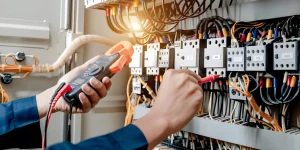Electrical wiring issues can lead to significant hazards if not identified early. Common signs include discoloration around outlets, flickering lights, and frequent circuit breaker trips. Inspecting these indicators is vital for maintaining safety. Learning how to identify electrical wiring issues involves recognizing these warning signs and knowing what they might indicate. Proper techniques and tools are necessary for an effective evaluation. Understanding when to take action or consult a professional can make all the difference in preventing catastrophic failures. What steps should one take to guarantee their electrical system remains secure?
Key Takeaways
- Regularly inspect outlets and switches for discoloration or burn marks, which indicate overheating or damage.
- Test circuits with a multimeter to ensure voltage levels are within the acceptable range.
- Look for flickering lights, as they can signify loose connections or voltage fluctuations.
- Listen for unusual sounds like buzzing or crackling, which may indicate electrical arcing.
- Check for warm outlets, as this can suggest overheating and potential fire risks.
Common Signs of Electrical Wiring Issues
When homeowners remain vigilant, they can often detect common signs of electrical wiring issues before they escalate into serious hazards. Notable indicators include flickering lights, which may suggest loose connections or voltage fluctuations. Additionally, the presence of warm or discolored outlets can signify overheating, potentially leading to fire risks. Strange odors, particularly burnt plastic, often indicate insulation damage. Frequent circuit breaker trips may also point to overloaded circuits or faulty wiring. Homeowners should remain alert to unusual sounds, such as buzzing or crackling, which may hint at electrical arcing. By recognizing these signs, individuals can take timely action, ensuring their homes remain safe and well-functioning, and fostering a sense of community responsibility towards electrical safety.
Safety Precautions When Inspecting Wiring
A thorough understanding of safety precautions is vital for anyone inspecting electrical wiring. Before commencing an inspection, individuals must guarantee that power is disconnected to prevent electrical shock. Utilizing insulated tools is critical, as they provide a protective barrier against accidental contact with live wires. Additionally, wearing appropriate personal protective equipment, such as gloves and safety goggles, enhances safety by reducing the risk of injury. Inspectors should also be aware of their surroundings, identifying potential hazards such as water sources or flammable materials. Finally, maintaining proper ventilation is important when working in enclosed spaces to mitigate the risk of inhaling harmful fumes. These measures collectively guarantee a safe environment while learning how to identify electrical wiring issues effectively.
Tools Needed to Identify Electrical Wiring Issues
Identifying electrical wiring issues requires the right set of tools to facilitate an effective inspection. Essential tools include a multimeter, which measures voltage, current, and resistance, enabling the detection of faulty connections. A non-contact voltage tester provides a quick assessment of live wires without direct contact, enhancing safety. Wire strippers and crimping tools assist in repairing or replacing damaged sections efficiently. A circuit tester can pinpoint problems within specific circuits, while an insulation resistance tester evaluates the integrity of wire insulation. Additionally, a flashlight is essential for illuminating dimly lit areas during inspections. Each tool plays a significant role in identifying electrical wiring issues, ensuring a thorough and safe evaluation of the electrical system.
Step-by-Step Guide to Inspecting Your Electrical System
To effectively assess an electrical system, a systematic approach is essential. The inspection process begins by ensuring the power is turned off at the main circuit breaker. Next, visually examine outlets and switches for signs of damage, such as discoloration or burn marks. Following this, check for the presence of ground wires in outlets, as this is vital for safety. Then, use a multimeter to measure voltage levels, ensuring they fall within the acceptable range. Additionally, inspect the main electrical panel for rust or loose connections. Finally, evaluate the overall condition of wiring, looking for fraying or deterioration. By adhering to this step-by-step guide, homeowners can effectively identify electrical wiring issues before they escalate into serious problems.
When to Call a Professional Electrician
How can homeowners determine the right moment to enlist the expertise of a professional electrician? Recognizing specific signs can prevent minor issues from escalating into serious hazards. Homeowners should consider contacting an electrician if they observe any of the following conditions:
- Frequent circuit breaker tripping
- Flickering or dimming lights
- Burning smells or scorch marks around outlets
- Outdated or non-compliant wiring systems
- GFCI outlets that won’t reset
These indicators often signify underlying electrical wiring issues that require professional assessment. By addressing these concerns early, homeowners can guarantee safety and maintain the integrity of their electrical systems. This proactive approach fosters a sense of belonging within a community that prioritizes safety and well-being.
Frequently Asked Questions
Can Outdated Wiring Be a Fire Hazard?
Outdated wiring can indeed pose a significant fire hazard. Deterioration over time may lead to short circuits or overheating, increasing the risk of electrical fires, necessitating regular inspections to guarantee safety and compliance with modern standards.
How Often Should I Inspect My Electrical Wiring?
Regular inspections of electrical wiring are essential, ideally every three to five years. This proactive approach minimizes risks, ensuring safety and reliability. Maintaining awareness fosters a sense of community responsibility regarding electrical system integrity and safety.
What Should I Do if I Find Damaged Wiring?
Upon discovering damaged wiring, immediate action is essential. One should disconnect power, assess the extent of damage, and consult a licensed electrician for repairs, ensuring safety and compliance with electrical standards. Timely intervention prevents further hazards.
Are There Specific Codes for Residential Wiring?
Specific codes for residential wiring vary by region and are designed to guarantee safety and compliance. These regulations dictate installation practices, materials, and safety measures, promoting a secure environment for homeowners and fostering community standards.
Can I Upgrade My Wiring Myself?
Upgrading wiring independently is possible for those with adequate knowledge and skills. However, it is essential to adhere to local codes and safety standards, as improper installation may lead to hazardous situations and potential code violations.
Conclusion
In summary, identifying electrical wiring issues early is vital for maintaining safety and functionality within a home. By recognizing common signs such as discoloration, flickering lights, or frequent circuit breaker trips, homeowners can take proactive measures. Utilizing appropriate tools and following a systematic inspection process enhances the likelihood of detecting potential hazards. Ultimately, when in doubt, seeking the expertise of a professional electrician is imperative to guarantee the integrity of the electrical system and prevent serious consequences.
You May Also Like To Read:






